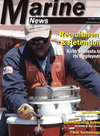
Page 16: of Marine News Magazine (October 2013)
Manning: Recruitment & Retention
Read this page in Pdf, Flash or Html5 edition of October 2013 Marine News Magazine
INSIGHTSunderstanding of the mission of Massachusetts Maritime Academy and the type of graduates that we produce. We focused our energies on meeting the employer?s needs and educating our cadets not just on the professional require- ments of the job, but the career opportunities available in the inland towing industry. Our graduates understand that while they are highly trained, they are not going to walk directly into the wheelhouse of a towing vessel. The tow- ing industry requires a level of knowledge of the particulars of the vessels involved and the inland/western river waters only learned by hands on experience. Our graduates actu- ally welcome six months to a year of training before being cut loose as a Mate or Pilot of a towing vessel and the tow- ing companies understand they are getting highly trained mariners that need to be ?seasoned? in the particulars of their trade. Each summer, MMA sends cadets to our part- ner companies such as Kirby Inland Marine for six to eight weeks. During the internships, cadets work aboard tugs and barges gaining great experience and insight into the inland towing industry. The practice of ?performance based assessments? is a growing trend in industry. These assessments typically go far beyond mere STCW compliance. Al- though so far primarily a blue water practice, it is occurring in brown water, too. Are cadets getting enough simulator time at present to prepare them for the real world? Performance-based assessments are a method of de- termining if a student can perform a task or ability at a pre-determined level of competency. Sometimes the as- sessments are performed on board vessels, such as the T/S Kennedy, and sometimes these assessments are completed in the simulator. While both teaching platforms have their strengths, simulators are wonderful teaching and learning tools because of the endless array of situations that a stu-dent can be taught or tested in without risk. Simulation is such an important part of the curriculum that the aver- age Marine Transportation cadet takes about 20 percent of their credit load in simulation-based courses. Simulators, however, are a costly investment. A maritime academy pre- paring new third mates must acquire simulation for Radar/ ARPA, ECDIS, Full Mission Bridge and GMDSS in order to ensure that STCW standards are being met. Expendi- tures in simulation at the Massachusetts Maritime Acad- emy total about $3.5 million in the past three years alone. These expenditures include a new 360°-full mission bridge simulator and necessary updates to our Radar/ARPA simu- lators. Massachusetts Maritime Academy now also has a full time staff of four Information Technology employees that directly support the simulation program. Engineroom simulation is also becoming more preva- lent. Tell us about the capabilities of your engineer- ing department in this way ? especially since you still produce about twice as many engineers as licensed deck of cers.We presently are using pc-based engineering software instead of full mission simulation for engineers. Dialogue recently occurred with this academy asking the Nation- al Maritime Center (NMC) if PC-based software would satisfy assessment standards. NMC has said that they will review the submission, but in general, the U.S. academies have discussed this topic and see very cost effective value in PC-based simulation which can include faults while pro- viding authentic system interface. The maritime academies are fully support of PC-based desk top simulation for the engineers, especially knowing that entire propulsion plants can today be operated from a computer monitor. Finally, attending a quasi-military academy probably isn?t for everyone. With so much competition from the so-called ?apprentice? programs in the coastal and inland workboat trades, what can you offer as the primary bene t to hiring one of yours, as oppose to somebody else? The 46 CFR Part 310 requires the U.S. maritime acad- emy cadets to participate in a minimum of three years of regimental structure. A regimental program rst instills how to be a good follower, where one learn how to takes orders, followed by a prescribed set of rules and become part of a team while being responsible for themselves and their shipmates. Followship then converts to leadership as an upperclassman, where now management and leadership blend to test varying degree of responsibility while hon- ing critical think skills. A seafarer must be able to make good decisions based on variables provided at any moment in time. A common thread woven among all the skills required of seafarers is critical thinking. The educational process which occurs both in and out of the classroom at a maritime academy emphasizes the importance and honing of critical thinking skills. Good critical thinking skills re- sults in a decisive person making the right decisions which results in strengthening one?s con dence to lead and man- age others. That?s the real value in the maritime Academy style of education.October 201316 MNMN October2013 Layout 1-17.indd 16MN October2013 Layout 1-17.indd 169/30/2013 2:15:36 PM9/30/2013 2:15:36 PM

 15
15

 17
17
